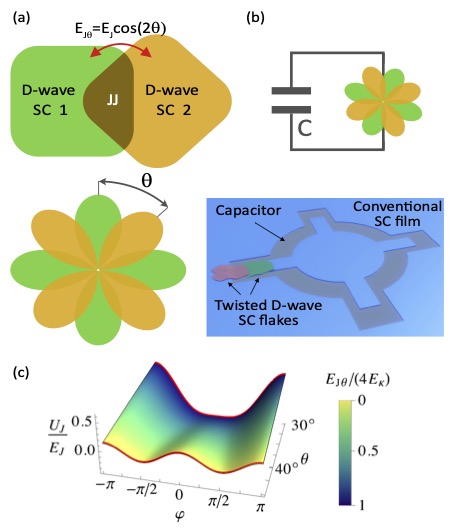Superconducting Qubit Based on Twisted Cuprate Van der Waals Heterostructures in Physical Review Letters
ISC researcher Valentina Brosco coauthored an interesting research proposing a novel superconduting qubit desigm. The work has been selected for an Editor’s Suggestion in Physical Review Letters, see Superconducting Qubit Based on Twisted Cuprate Van der Waals Heterostructures V. Brosco, G. Serpico, V. Vinokur, N. Poccia and U. Vool, Phys. Rev. Lett. 132, 017003 (2024).
Abstract
Van-der-Waals assembly enables the fabrication of novel Josephson junctions featuring an atomically sharp interface between two exfoliated and relatively twisted Bi2Sr2CaCu2O8+x (Bi2212) flakes. In a range of twist angles around 45°, the junction provides a regime where the interlayer two-Cooper pair tunneling dominates the current-phase relation. Here we propose employing this novel junction to realize a capacitively shunted qubit that we call flowermon. The d-wave nature of the order parameter endows the flowermon with inherent protection against charge-noise-induced relaxation and quasiparticle-induced dissipation. This inherently protected qubit paves the way to a new class of high-coherence hybrid superconducting quantum devices based on unconventional superconductors.

Potential design for the flowermon qubit. (a) A relative twist of two d-wave flakes placed together to form a Josephson junction can suppress Cooper pair tunneling due to momentum mismatch. At 45° the mismatch completely suppresses single Cooper pair tunneling, and two-pair tunneling dominates the junction. (b) The design of the flowermon with a single d-wave junction shunted by a large capacitor similar to the transmon qubit. The 3D design shows a possible physical implementation with the capacitor pads of a conventional superconductor coupled to the junction. (c) Josephson’s potential for different values of the twist angle.
See also the short interview on phys.org


